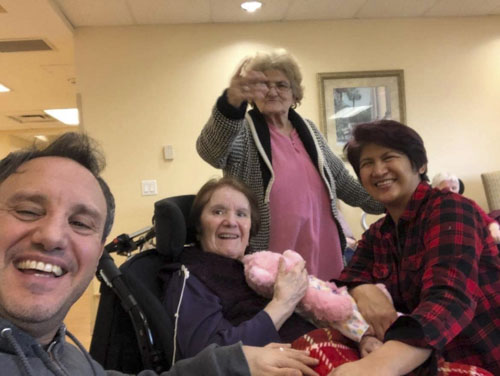Written by Rochelle Guida
In the above photo: El Nido Bay in the province of Palawan, Philippines
CASLT’s Discovering Languages series aims to spark interest in plurilingualism and pluriculturalism among language learners, school communities, and the public. Each featured language is explored in a blog article and accompanied by a classroom-ready activity for language teachers. Use these activities to promote and popularize language learning among your students and help them develop intercultural competencies.
The history of the Philippines is rich and complex, with influences from Malay, Chinese, Spanish, and American cultures and representing over “300 languages and dialects.” Tagalog is one of the languages of the Philippines, with a strong presence in Manila, Luzon, and several islands of the country. Tagalog means “resident beside the river,” which is fitting considering the abundant waters that surround this beautiful country.

In 1937, the Philippine government established Tagalog as the official language, yet other spoken languages continue to exist in the country, including “Cebuano, Ilokano, Hiligaynon, Kinaray-a, Kapampangan, and Bikolano.” Today, Tagalog remains one of the most widely spoken languages, with around 28 million speakers in the Philippines, and extends its popularity as the “sixth most-spoken language” in the United States.
While researchers have observed slight differences between Filipino and Tagalog, according to Jayson Parba’s work, Empowering the Filipino Language Classroom: Towards Critical Pedagogy and Curriculum, it is quite common for native speakers to “interchangeably” use Tagalog or Filipino when describing their language (p. 154). Incorporating English is also popular in Tagalog, which has been identified as “Taglish” (p. 155). For example, saying Yes po! is a sign of respect to an elder or to any individual. It is also a highly recommended Taglish expression for non-native Tagalog speakers when recognizing the hospitable Filipino culture.
Features of Tagalog
According to the Omniglot Online Encyclopedia, Tagalog was originally transcribed with Baybayin script, but now uses the Latin alphabet. Many words from Tagalog have connections to “Spanish, English, Min Nan Chinese, Malay, Sanskrit, Arabic, Tamil, Persian, Kapampangan, and other Austronesian languages.” Without a doubt, the Spanish language has a strong presence in Tagalog. In fact, the first dictionary, book, and grammar “were created by Spanish clergymen during the 300-year Spanish occupation of the Philippines.” MustGo.com provides concrete examples of how Tagalog has roots in a variety of world languages:
| Tagalog word | Borrowed from |
| kabayo | Spanish caballo “horse” |
| Kumusta? | Spanish ¿Como está? “How are you?” |
| libró | Spanish libro “book” |
| nars | English “nurse” |
| drayber | English “driver” |
| saráp | Malay sedap “delicious” |
| balità | Sanskrit berita “news” |
| bundók | Kapampangan bunduk “mountain” |
After marrying my uncle, my new Filipino aunt addressed herself as my Tiya, which pleased me very much. Connecting the word Tiya from Tagalogto Tía from Spanish instantly introduced me to the interconnectedness of the two languages. Parents who speak Tagalog often give their children Spanish names for reasons including “a 19th-century Spanish decree that required them to use Spanish surnames.” Parents also commonly named their child “after the saint whose feast day was on the day of their birth.”
Key Teachings From Filipino Culture
Due to the historical, cultural, and linguistic connections from other countries, it is not surprising that Filipino culture warmly embraces all communities. According to a resource prepared by Dr. Margaret Malixi of California State University, “Filipino people tend to be very hospitable, especially to Western visitors” and value the importance of family life and maintaining peaceful relationships, avoiding conflicts whenever possible.
My Tiya Evelyn was our role model in maintaining genuine, loving relationships with all family members. She was the first person to jump at the chance to wash my grandfather’s hair after a long day in the garden, and always made sure to laugh at my grandparents’ jokes. I cannot remember a time when she ever spoke poorly about a family member or friend. Despite suffering from dementia now, my dear Tiya still sings her prayers enthusiastically with her friends and fellow parishioners, which inspires me to maintain my own faith traditions and become a better human being.

Being a Bayan: Spreading Kindness in the Additional Language Classroom
Activity Objective
The objective of this activity is to promote kindness and empathy among students while also introducing them to the concept of Bayanihan, a traditional Filipino value that emphasizes the importance of community and co-operation. This activity can be completed for any age level and program, as modified by the teacher. The suggested duration is 30–40 minutes, including discussion time.
Materials
- Large sheet of paper
- Markers
- Index cards
Procedure
- Begin by introducing the word “bayan” and the concept of Bayanihan to the class. Explain that Bayanihan is a Filipino cultural value that emphasizes the importance of community and co-operation, often demonstrated through acts of kindness and helping others.
- Ask the students to brainstorm some examples of acts of kindness, community building, and co-operation that they can do for their classmates, teachers, or even strangers. Next, they can continue brainstorming more specific examples relative to the language classroom. Write these ideas on a large sheet of paper. This should be discussed in the target language of the classroom, with teacher assistance when necessary. Language conventions such as the present tense can be reinforced.
- Divide the class into pairs or small groups and distribute index cards to each group. Instruct the students to write down, in the target language, one act of kindness, community building, or co-operation that they would like to do for someone in their group or class. Specify that they should choose acts that are possible to carry out in the classroom setting. Encourage them to be creative and thoughtful for the additional language context. For example, students can imagine being in the target language community and having to act appropriately while resolving a language task.
- Collect the index cards, shuffle them, and redistribute them to different groups. Each group should receive a card with an act of kindness that another group wrote down.
- Instruct each group to carry out the act of kindness written on their new card. Encourage them to work together and support each other to accomplish the task.
- After the activity, reconvene the class and discuss how it felt to both receive and give acts of kindness. Ask students to share their thoughts on how the activity relates to the concept of Bayanihan.
- Finally, ask each group to write down one thing they learned about kindness and Bayanihan during the activity and share it with the rest of the class. This could be part of the students’ language journal.
Assessment
Observe the students during the activity to ensure that they are working together and supporting each other to accomplish their tasks. After the activity, assess the quality of their reflections and how well they were able to connect the concept of Bayanihan to acts of kindness in their community.
This activity promotes not only language skills but also cultural awareness and empathy. By promoting acts of kindness, we can help students develop a sense of community and belonging while also instilling values that are important in Filipino culture.




